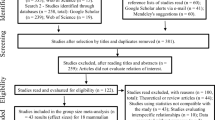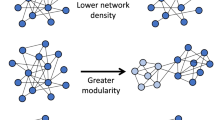Abstract
Knowledge of the structure of networks of social interactions is important for understanding the evolution of cooperation, transmission of disease, and patterns of social learning, yet little is known of how environmental, ecological, or behavioural factors relate to such structures within groups. We observed grooming, dominance, and foraging competition interactions in eight groups of wild meerkats (Suricata suricatta) and constructed interaction networks for each behaviour. We investigated relationships between networks for different social interactions and explored how group attributes (size and sex ratio), individual attributes (tenure of dominants), and ecological factors (ectoparasite load) are related to variation in network structure. Network structures varied within a group according to interaction type. Further, network structure varied predictably with group attributes, individual attributes, and ecological factors. Networks became less dense as group size increased suggesting that individuals were limited in their number of partners. Groups with more established dominant females were more egalitarian in their grooming and foraging competition interactions, but more despotic in their dominance interactions. The distribution of individuals receiving grooming became more skewed at higher parasite loads, but more equitable at low parasite loads. We conclude that the pattern of interactions between members of meerkat groups is not consistent between groups but instead depends on general attributes of the group, the influence of specific individuals within the group, and ecological factors acting on group members. We suggest that the variation observed in interaction patterns between members of meerkat groups may have fitness consequences both for individual group members and the group itself.




Similar content being viewed by others
References
Borgatti SP, Everett MG, Freeman LC (2002) UCInet for windows: software for social network analysis. Analytic Technologies, Harvard, MA
Brotherton PNM, Clutton-Brock TH, O’Riain MJ, Gaynor D, Sharpe L, Kansky R, McIlrath GM (2001) Offspring food allocation by parents and helpers in a cooperative mammal. Behav Ecol 12:590–599
Clutton-Brock TH, Gaynor D, Kansky R, MacColl ADC, McIlrath G, Chadwick P, Brotherton PNM, O’Riain JM, Manser M, Skinner JD (1998) Costs of cooperative behaviour in suricates, Suricata suricatta. Proc R Soc Lond B 265:185–190
Clutton-Brock TH, Brotherton PNM, Russell AF, O’Riain MJ, Gaynor D, Kansky R, Griffin A, Manser M, Sharpe L, McIlrath G, Small T, Moss A, Monfort S (2001) Cooperation, control, and concession in meerkat groups. Science 291:478–481
Clutton-Brock TH, Hodge SJ, Spong G, Russell AF, Jordan NR, Bennett NC, Manser MB (2006) Intrasexual competition in cooperative mammals. Nature 444:1065–1068
Croft DP, Krause J, James R (2004) Social networks in the guppy (Poecilia reticulata). Proc R Soc Lond B 271:S516–S519
Croft DP, James R, Ward AJW, Botham MS, Mawdsley D, Krause J (2005) Assortative interactions and social networks in fish. Oecologia 143:211–219
Croft DP, James R, Krause J (2008) Exploring animal social networks. Princeton University Press, Princeton
Cross PC, Lloyd-Smith JO, Getz WM (2005) Disentangling association patterns in fission-fusion societies using African buffalo as an example. Anim Behav 69:499–506
Doolan SP, Macdonald DW (1999) Co-operative rearing by slender-tailed meerkats (Suricata suricatta) in the southern Kalahari. Ethology 105:851–866
Drewe JA, Madden JR, Pearce GP (2009) The social network structure of a wild meerkat population: 1. Inter-group interactions. Behav Ecol Sociobiol 63:1295–1306
Flack JC, Girvan M, de Waal FBM, Krakauer DC (2006) Policing stabilizes construction of social niches in primates. Nature 439:426–429
Godfrey SS, Bull CM, James R, Murray K (2009) Network structure and parasite transmission in a group living lizard, the gidgee skink, Egernia stokesii. Behav Ecol Sociobiol 63:1045–1056
Griffin AS, Pemberton JM, Brotherton PNM, McIlrath G, Gaynor D, Kansky R, O’Riain J, Clutton-Brock TH (2003) A genetic analysis of breeding success in the cooperative meerkat (Suricata suricatta). Behav Ecol 4:472–480
Guimarães PR, Argollo de Menezes M, Barid RW, Lusseau D, Guimarães P, dos Reis SF (2007) Vulnerability of a killer whale social network to disease outbreaks. Phys Rev E Stat Nonlin Soft Matter Phys 76(4 Pt 1):042901
Hanneman RA, Riddle M (2005) Introduction to social network methods. Published in digital form at: http://www.faculty.ucr.edu/~hanneman/nettext/, University of California, Riverside
Hinde RA (1983) Primate social relationships. Blackwell, Oxford
Hodge SJ, Flower TP, Clutton-Brock TH (2007) Offspring competition and helper associations in cooperative meerkats. Anim Behav 74:957–964
Krause J, Croft D, James R (2007) Social network theory in the behavioural sciences: potential applications. Behav Ecol Sociobiol 62:15–27
Kutsukake N, Clutton-Brock TH (2006) Social functions of allogrooming in cooperatively breeding meerkats. Anim Behav 72:1059–1068
Kutsukake N, Clutton-Brock TH (2008) Do meerkats engage in conflict management following aggression? Reconciliation, submission and avoidance. Anim Behav 75:1441–1453
Lusseau D (2003) The emergent properties of a dolphin social network. Proc R Soc Lond B 270:S186–S188
Lusseau D, Newman MEJ (2004) Identifying the role that animals play in their social networks. Proc R Soc Lond B 271:S477–S481
Lusseau D, Wilson BEN, Hammond PS, Grellier K, Durban JW, Parsons KM, Barton TR, Thompson PM (2006) Quantifying the influence of sociality on population structure in bottlenose dolphins. J Anim Ecol 75:14–24
Madden JR, Clutton-Brock TH (2009) Manipulating grooming by decreasing parasite load causes unpredicted changes in antagonism. Proc R Soc Lond B 276:1263–1268
Manno TG (2008) Social networking in the Columbian ground squirrel, Spermophilus columbianus. Anim Behav 75:1221–1228
McCowan B, Anderson K, Heagarty A, Cameron A (2008) Utility of social network analysis for primate behavioral management and well-being. Appl Anim Behav Sci 109:396–405
McDonald DB (2007) Predicting fate from early connectivity in a social network. Proc Natl Acad Sci U S A 104:10910–10914
Nakamura M (2006) Lattice models in ecology and social sciences. Ecol Res 21:364–369
Naug D (2009) Structure and resilience of the social network in an insect colony as a function of colony size. Behav Ecol Sociobiol 63:1023–1028
Newman MEJ (2003) The structure and function of complex networks. SIAM Rev 45:167–256
Radford AN (2008) Duration and outcome of intergroup conflict influences intragroup affiliative behaviour. Proc R Soc Lond B 275:2787–2791
Ramos-Fernández G, Boyer D, Aureli F, Vick LG (2009) Association networks in the spider monkey (Ateles geoffroyi). Behav Ecol Sociobiol 63:999–1013
Ryder TB, McDonald DB, Blake JG, Parker PG, Loiselle BA (2008) Social networks in the lek-mating wire-tailed manakin (Pipra filicauda). Proc R Soc Lond B 275:1367–1374
Sokal RR, Rohlf FJ (1994) Biometry: principles and practice of statistics in biological research. W. H. Freeman and Co Ltd, New York
Sundaresan SR, Fischhoff IR, Dushoff J, Rubenstein DI (2007) Network metrics reveal differences in social organization between two fission-fusion species, Grevy’s zebra and onager. Oecologia 151:140–149
Thomas POR, Croft DP, Morrell LJ, Davis A, Faria JJ, Dyer JRG, Piyapong C, Ramnarine I, Ruxton GD, Krause J (2008) Does defection during predator inspection affect social structure in wild shoals of guppies. Anim Behav 75:43–53
Wasserman S, Faust K (1994) Social network analysis: methods and applications. Cambridge University Press, Cambridge
Wey T, Blumstein DT, Shen W, Jordán F (2008) Social network analysis of animal behaviour: a promising tool for the study of sociality. Anim Behav 75:333–344
Wolf JBW, Mawdsley D, Trillmich F, James R (2007) Social structure in a colonial mammal: unravelling hidden structural layers and their foundations by network analysis. Anim Behav 74:1293–1302
Young AJ, Carlson AA, Clutton-Brock T (2005) Trade-offs between extraterritorial prospecting and helping in a cooperative mammal. Anim Behav 70:829–837
Acknowledgements
We thank the owners of farms surrounding the Reserve for permission to study meerkats on their land and Northern Cape Conservation for allowing us to work in the Kalahari. Tom Flower, Rob Sutcliffe, and Dave Bell managed the Meerkat Project marvellously. We are greatly indebted to all the volunteers who assisted with data collection in the field. Martin Haupt of the University of Pretoria supplied invaluable logistical support. We thank the editor and two anonymous reviewers for helpful comments on the manuscript. JRM and THCB were funded by a BBSRC grant. JAD was funded by the Department for Environment, Food and Rural Affairs (DEFRA), and the Higher Education Funding Council for England (HEFCE) through the Cambridge Infectious Diseases Consortium.
Author information
Authors and Affiliations
Corresponding author
Additional information
Communicated by: J. Setchell
Rights and permissions
About this article
Cite this article
Madden, J.R., Drewe, J.A., Pearce, G.P. et al. The social network structure of a wild meerkat population: 2. Intragroup interactions. Behav Ecol Sociobiol 64, 81–95 (2009). https://doi.org/10.1007/s00265-009-0820-8
Received:
Revised:
Accepted:
Published:
Issue Date:
DOI: https://doi.org/10.1007/s00265-009-0820-8




